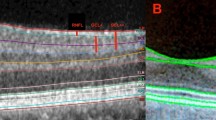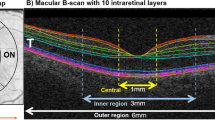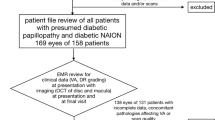Abstract
Purpose
To study the correlation of the local ganglion cell layer—inner plexiform layer (GCL-IPL) thickness with corresponding retinal sensitivity as studied with microperimetry in patients with Type 2 diabetes and no signs of diabetic retinopathy.
Patients and methods
We analyzed 35 healthy subjects (68 eyes) and 26 Type 2 diabetic patients (48 eyes) with no signs of diabetic retinopathy. We tested best corrected visual acuity (BCVA), monocular and binocular constrast sensitivity (CS, Pelli – Robson chart) and retinal sensitivity with microperimetry, and acquired dense macular SD-OCT scans. We then studied the correlation between local GCL-IPL thickness and local sensitivity.
Results
Mean BCVA was 1.09 (±1.03) decimals in diabetic subjects and 1.02 (±0.15) decimals in healthy subjects. Only binocular CS was significantly higher in healthy subjects (1.18±0.42 for healthy subjects, 1.62±0.63 for diabetic subjects). In both local and global analysis we observed higher GCL-IPL thickness and higher sensitivity in normal compared with diabetic subjects, but no difference reached significance (p<0.05). Using a mixed multivariate linear model, we found a significant correlation between retinal sensitivity and the correspondent GCL-IPL thickness in diabetic subjects (0.022±0.006 dB/μm, p=0.0007) but not in healthy subjects (−0.002±0.006 dB/μm, p=0.77).
Conclusion
despite close similarities between the two groups, we found a significant difference in the structure–function relationship in diabetic subjects without diabetic retinopathy, suggesting that diabetes might act as an additional effect in the normal deterioration of the visual function related to the inner retina.
Similar content being viewed by others
Log in or create a free account to read this content
Gain free access to this article, as well as selected content from this journal and more on nature.com
or
References
Engelgau MM, Geiss LS, Saaddine JB, Boyle JP, Benjamin SM, Gregg EW et al. The evolving diabetes burden in the United States. Ann Intern Med 2004; 140 (11): 945–950.
Ciulla TA, Amador AG, Zinman B . Diabetic retinopathy and diabetic macular edema: pathophysiology, screening, and novel therapies. Diabetes Care 2003; 26 (9): 2653–2664.
Wolter JR . Diabetic retinopathy. Am J Ophthalmol 1961; 51: 1123–1141.
Bloodworth JM Jr. . Diabetic retinopathy. Diabetes 1962; 11: 1–22.
Han Y, Adams AJ, Bearse MA Jr, Schneck ME . Multifocal electroretinogram and short-wavelength automated perimetry measures in diabetic eyes with little or no retinopathy. Arch Ophthalmol 2004; 122 (12): 1809–1815.
Realini T, Lai MQ, Barber L . Impact of diabetes on glaucoma screening using frequency-doubling perimetry. Ophthalmology 2004; 111 (11): 2133–2136.
Greenstein VC, Shapiro A, Zaidi Q, Hood DC . Psychophysical evidence for post-receptoral sensitivity loss in diabetics. Invest Ophthalmol Vis Sci 1992; 33 (10): 2781–2790.
Abu-El-Asrar AM, Dralands L, Missotten L, Al-Jadaan IA, Geboes K . Expression of apoptosis markers in the retinas of human subjects with diabetes. Invest Ophthalmol Vis Sci 2004; 45 (8): 2760–2766.
Leung CK, Weinreb RN, Li ZW, Liu S, Lindsey JD, Choi N et al. Long-term in vivo imaging and measurement of dendritic shrinkage of retinal ganglion cells. Invest Ophthalmol Vis Sci 2011; 52 (3): 1539–1547.
van Dijk HW, Kok PH, Garvin M, Sonka M, Devries JH, Michels RP et al. Selective loss of inner retinal layer thickness in type 1 diabetic patients with minimal diabetic retinopathy. Invest Ophthalmol Vis Sci 2009; 50 (7): 3404–3409.
van Dijk HW, Verbraak FD, Kok PH, Stehouwer M, Garvin MK, Sonka M et al. Early neurodegeneration in the retina of type 2 diabetic patients. Invest Ophthalmol Vis Sci 2012; 53 (6): 2715–2719.
Carpineto P, Toto L, Aloia R, Ciciarelli V, Borrelli E, Vitacolonna E et al. Neuroretinal alterations in the early stages of diabetic retinopathy in patients with type 2 diabetes mellitus. Eye 2016; 30 (5): 673–679.
Chhablani J, Sharma A, Goud A, Peguda HK, Rao HL, Begum VU et al. Neurodegeneration in Type 2 diabetes: evidence from spectral-domain optical coherence tomography. Invest Ophthalmol Vis Sci 2015; 56 (11): 6333–6338.
Antonetti DA, Lieth E, Barber AJ, Gardner TW . Molecular mechanisms of vascular permeability in diabetic retinopathy. Semin Ophthalmol 1999; 14 (4): 240–248.
De Benedetto U, Querques G, Lattanzio R, Borrelli E, Triolo G, Maestranzi G et al. Macular dysfunction is common in both type 1 and type 2 diabetic patients without macular edema. Retina 2014; 34 (11): 2171–2177.
Verma A, Rani PK, Raman R, Pal SS, Laxmi G, Gupta M et al. Is neuronal dysfunction an early sign of diabetic retinopathy? Microperimetry and spectral domain optical coherence tomography (SD-OCT) study in individuals with diabetes, but no diabetic retinopathy. Eye 2009; 23 (9): 1824–1830.
Drasdo N, Millican CL, Katholi CR, Curcio CA . The length of Henle fibers in the human retina and a model of ganglion receptive field density in the visual field. Vis Res 2007; 47 (22): 2901–2911.
Turpin A, Chen S, Sepulveda JA, McKendrick AM . Customizing structure–function displacements in the macula for individual differences. Invest Ophthalmol Vis Sci 2015; 56 (10): 5984–5989.
Curcio CA, Allen KA . Topography of ganglion cells in human retina. J Comp Neurol 1990; 300 (1): 5–25.
Sokol S, Moskowitz A, Skarf B, Evans R, Molitch M, Senior B . Contrast sensitivity in diabetics with and without background retinopathy. Arch Ophthalmol 1985; 103 (1): 51–54.
Bearse MA Jr., Han Y, Schneck ME, Barez S, Jacobsen C, Adams AJ . Local multifocal oscillatory potential abnormalities in diabetes and early diabetic retinopathy. Invest Ophthalmol Vis Sci 2004; 45 (9): 3259–3265.
Rossetti L, Digiuni M, Rosso A, Riva R, Barbaro G, Smolek MK et al. Compass: clinical evaluation of a new instrument for the diagnosis of glaucoma. PLoS ONE 2015; 10 (3): e0122157.
Fogagnolo P, Modarelli A, Oddone F, Digiuni M, Montesano G, Orzalesi N et al. Comparison of Compass and Humphrey perimeters in detecting glaucomatous defects. Eur J Ophthalmol 2016; 26 (6): 598–606.
Author information
Authors and Affiliations
Corresponding author
Ethics declarations
Competing interests
Luca Rossetti received compensation as a consultant for Centervue, Padua. All other authors have no financial relationships to disclose.
Rights and permissions
About this article
Cite this article
Montesano, G., Gervasoni, A., Ferri, P. et al. Structure–function relationship in early diabetic retinopathy: a spatial correlation analysis with OCT and microperimetry. Eye 31, 931–939 (2017). https://doi.org/10.1038/eye.2017.27
Received:
Accepted:
Published:
Issue date:
DOI: https://doi.org/10.1038/eye.2017.27
This article is cited by
-
Early response of anti-vascular endothelial growth factor (anti-VEGF) in diabetic macular edema (DME) management: microperimetry and optical coherence tomography (OCT) findings: a pilot study at national eye center of third world country
BMC Ophthalmology (2024)
-
Influence of OCT biomarkers on microperimetry intra- and interdevice repeatability in diabetic macular edema
Scientific Reports (2024)
-
Electrophysiological findings in long-term type 1 diabetes patients without diabetic retinopathy using different ERG recording systems
Scientific Reports (2024)
-
Multiple instance learning based classification of diabetic retinopathy in weakly-labeled widefield OCTA en face images
Scientific Reports (2023)
-
Identifying the severity of diabetic retinopathy by visual function measures using both traditional statistical methods and interpretable machine learning: a cross-sectional study
Diabetologia (2023)



